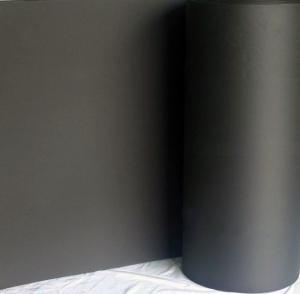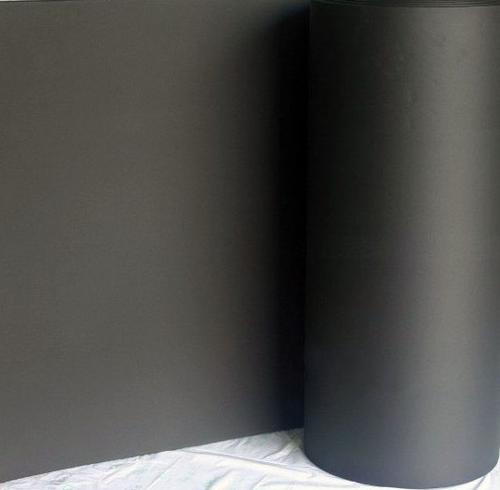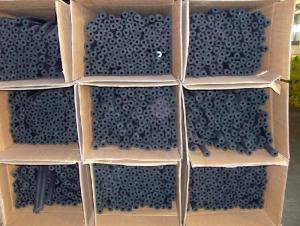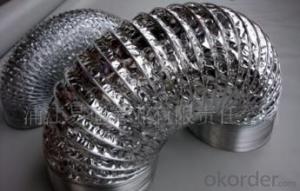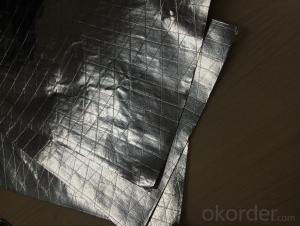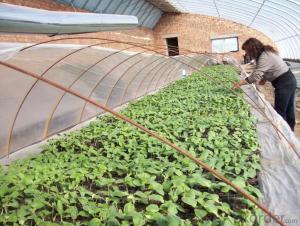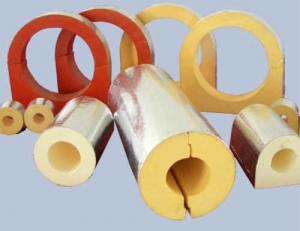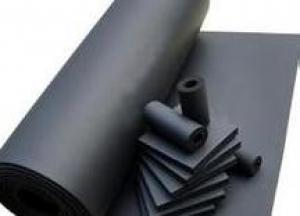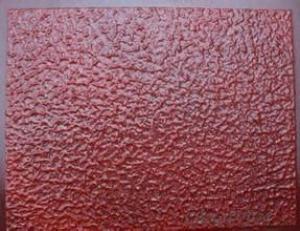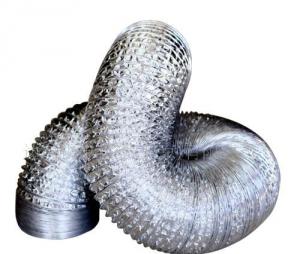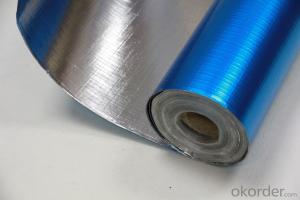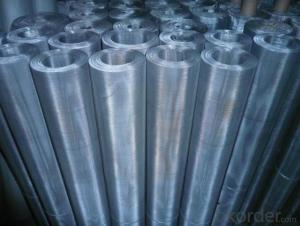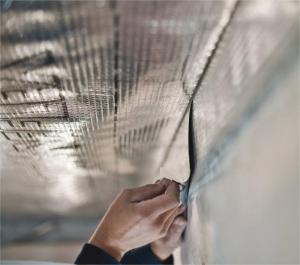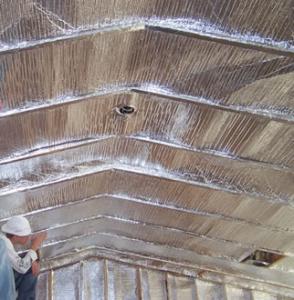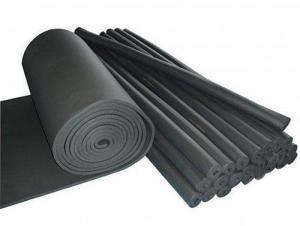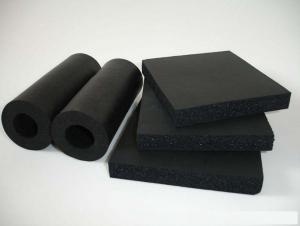Flexible Elastomeric Thermal Insulation
- Loading Port:
- China Main Port
- Payment Terms:
- TT OR LC
- Min Order Qty:
- -
- Supply Capability:
- -
OKorder Service Pledge
OKorder Financial Service
You Might Also Like
RUBBER PLASTIC Flexible Elastomeric Thermal Insulation
rubber plastic isa high quality heat-insulating and heat-preservation material which use butyronitrile rubber and polyvinychloride(NBR,PVC) as main raw materials.
The productionprocess includes mixing, tensing and continuous extruding , heating andfoaming, cooling and cutting.
FEATURES
Lower heat-conductivity
Higher fire-blockingperformance
Damp-proof andWater-proof
Softness
Neat and
Easy to installeasy handing and storage
Good flexibilityand tenacity
RUBBER PLASTIC SHEET
Standard Size
Density(kg/m3) | 40-90 | ||||
Thickness(mm) | 10 mm | 15 mm | 20 mm | 25 mm | 30 mm |
Length (m) | 20 | 20 | 10 | 10 | 10 |
Width (m) | 1.5 | 1.5 | 1.5 | 1.5 | 1.5 |
Remark: Othersized are available upon request. Other colors are available at customers request.
Application
rubber plastic arewidely used in sound isolation of wall planking, sound absorption in air ducts,and sound absorbing decorations in entertainment spaces. It can also be usedfor shock resistance and pressure relief in instruments and equipment.
TechnicalParameters
Item | Specification | Standard |
Density(kg/m3) | 40-90 | GB/T 6343 |
Temperature(℃) | -40~110 | GB/T 17794 |
Flammability | Class B | GB/T 8624-2006 |
Class 0 | BS 476Part7∝Part6 | |
Oxygen index (%) | ≥40 | GB/T 2406 |
SDR | ≤65 | GB/T8627-1999 |
Conductivity factor Average temperature | ≤0.031 | GB/T 10294 |
Water vapor permeability (%) | ≥1.0x104 | GB/T 17146-1997 |
≤1.96x 10-11 | ||
Water absorption ratio in vacuum (%) | ≤10 | GB/T 17794-2008 |
Dimension stability(N/cm) | ≤10 | GB/T 8811 |
Crack resistance | ≥2.5 | GB/T 10808 |
Compression resilience ratio (%) | ≥70 | GB/T 6669 |
Anti-ozone | No cracking | GB/T 7762 |
Ageing-resistance | Slightly crumpling, no cracks no pin holes, not deforming | GB/T 16259 |
Packaging,
Product is packedin cartoon.
RUBBER PLASTIC PIPE
Productintroduction
rubber plastic ismainly applicable to heat insulation of central air-conditioner system,refrigerator room and pipes of all kinds of refrigeration equipment and heatingequipment.
Standard Size
Copper tube OD inch | Seamless tube OD mm | Galvanized tube DN | ID mm | 9mm Nominal thickness | 15mm Nominal thickness | 20mm Nominal thickness | 25mm Nominal thickness | 30mm Nominal thickness | |||||
mm×mm | piece | mm×mm | piece | mm×mm | piece | mm×mm | piece | mm×mm | piece | ||||
1/4 |
|
| 6 | 6×9 | 180 |
|
|
|
|
|
|
|
|
3/8 |
| 6 | 10 | 10×9 | 140 | 10×15 | 80 | 10×20 | 70 |
|
|
|
|
1/2 |
|
| 13 | 13×9 | 120 | 13×15 | 80 | 13×20 | 50 |
|
|
|
|
5/8 | 14 | 8 | 16 | 16×9 | 100 | 16×15 | 60 | 16×20 | 50 |
|
|
|
|
3/4 |
|
| 19 | 19×9 | 100 | 19×15 | 60 | 19×20 | 40 |
|
|
|
|
7/8 | 22 | 15 | 22 | 22×9 | 100 | 22×15 | 60 | 22×20 | 40 | 22×25 | 30 | 22×30 | 25 |
1 | 25 |
| 25 | 25×9 | 80 | 25×15 | 60 | 25×20 | 30 | 25×25 | 25 | 25×30 | 25 |
1 1/8 | 28 | 20 | 28 | 28×9 | 60 | 28×15 | 50 | 28×20 | 30 | 28×25 | 25 | 28×30 | 20 |
1 1/4 | 32 |
| 32 | 32×9 | 60 |
|
|
|
|
|
|
|
|
1 1/4 | 32 |
| 34 |
|
| 34×15 | 40 | 34×20 | 30 | 34×25 | 25 | 34×30 | 20 |
1 3/8 |
| 25 | 35 | 35×9 | 60 |
|
|
|
|
|
|
|
|
1 1/2 |
|
|
| 38×9 | 50 |
|
|
|
|
|
|
|
|
1 5/8 |
| 25 | 42 | 42×9 | 50 |
|
|
|
|
|
|
|
|
1 5/8 |
| 32 | 43 | 43×9 | 50 | 43×15 | 30 | 43×20 | 25 | 43×25 | 20 | 43×30 | 15 |
1 7/8 |
| 40 | 48 | 48×9 | 50 | 48×15 | 30 | 48×20 | 25 | 48×25 | 20 | 48×30 | 15 |
2 1/8 |
|
| 54 | 54×9 | 50 |
|
|
|
|
|
|
|
|
2 3/8 |
| 50 | 60 | 60×9 | 50 | 60×15 | 30 | 60×20 | 20 | 60×25 | 15 | 60×30 | 15 |
| 76 | 70 | 76 |
|
| 76×15 | 25 | 76×20 | 15 | 76×25 | 15 | 76×30 | 10 |
| 89 | 80 | 89 |
|
|
|
| 89×20 | 15 | 89×25 | 15 | 89×30 | 10 |
| 108 |
| 108 |
|
|
|
| 108×20 | 15 | 108×25 | 10 | 108×30 | 10 |
- Q: What are the options available to replace aluminum foil when covering food?
- <p>Yes, there are several alternatives to aluminum foil for covering food. Silicone food covers are reusable, heat-resistant, and can be easily washed. Beeswax wraps are an eco-friendly option, made from natural materials and can be used multiple times. Parchment paper is a disposable option that's ideal for baking and can be used in place of foil. Reusable glass or ceramic lids can be used for dishes that need to be covered while cooking. Lastly, some people opt for reusable metal mesh covers, which are suitable for grilling and baking. Each alternative has its own benefits and is chosen based on the specific needs and preferences of the user.</p>
- Q: This question asks for the most effective method to smooth out wrinkles in aluminum foil facing material.
- <p>The best way to remove wrinkles from aluminum foil facing is to use a combination of heat and gentle stretching. First, preheat your iron on a low setting without steam. Place a thin cloth or parchment paper over the wrinkled aluminum foil facing to protect it from direct heat. Then, gently press the iron over the cloth, moving in a smooth, continuous motion. As the foil warms, it will become more pliable, allowing you to gently stretch and smooth out the wrinkles. Be cautious not to apply too much pressure or heat, as this can damage the foil.</p>
- Q: Explain how to best utilize aluminum foil facing in the preparation of a sandwich.
- <p>The best ways to use aluminum foil facing in a sandwich include: 1) Wrapping the sandwich to keep it fresh and prevent it from drying out, especially when storing for later. 2) Using it as a makeshift 'grill' by placing the sandwich between two sheets of foil and toasting it in a panini press or on a stovetop for a crispy exterior. 3) Creating a foil pouch by sealing the sandwich in foil, which can be used for cooking sandwiches in an oven or on a campfire, keeping the ingredients moist and tender. 4) Using foil to press down on the sandwich while grilling or toasting, ensuring even heat distribution and a uniform texture. Always ensure the foil is food-safe and does not come into direct contact with the sandwich's fillings to avoid any potential contamination.</p>
- Q: Is it possible to use aluminum foil facing as a substitute for a roasting pan?
- <p>While aluminum foil facing can be used in some baking situations, it is not recommended to use it as a direct substitute for a roasting pan. Aluminum foil is not designed to withstand the high temperatures of a roasting process and can melt or warp, leading to uneven cooking and potential safety hazards. A proper roasting pan is made to handle high heat and distribute it evenly, ensuring that your food cooks properly. For best results and safety, use a designated roasting pan or a baking sheet with a higher heat tolerance.</p>
- Q: This question asks for a comparison of the benefits and drawbacks associated with the use of aluminum foil facing in various applications.
- <p>Aluminum foil facing offers several advantages, including excellent heat reflection, which can improve insulation and energy efficiency in buildings. It also provides a moisture barrier, which can protect against water damage and mold growth. Additionally, aluminum foil facing is lightweight, easy to install, and resistant to corrosion. However, there are disadvantages such as its limited strength and durability compared to other materials, making it prone to punctures and tears. It can also be less aesthetically pleasing and may require additional protective layers for long-term use. Furthermore, improper disposal can contribute to environmental concerns due to its non-biodegradable nature.</p>
- Q: What precautions can be taken to prevent burns while using aluminum foil in cooking or baking?
- <p>To avoid getting burned when using aluminum foil for cooking or baking, follow these safety tips: Always handle the foil with utensils or wear heat-resistant gloves. Avoid touching the foil directly after cooking or baking, as it can retain heat. Use heavy-duty aluminum foil to prevent punctures and tears that can cause burns. Keep aluminum foil away from open flames or high heat sources to prevent it from catching fire. Always use caution when removing aluminum foil from an oven or stovetop, and let it cool slightly before handling.</p>
- Q: Is it safe to use aluminum foil facing inside a microwave oven?
- <p>No, it is not safe to use aluminum foil facing in the microwave oven. Aluminum foil can cause sparks and potentially start a fire due to the reflective nature of the metal. It can also damage the oven's interior. Always use microwave-safe materials and avoid metal when cooking in a microwave.</p>
- Q: What are the negative effects on the environment when aluminum foil facing is utilized?
- <p>The environmental impacts of using aluminum foil facing include increased waste generation due to its non-biodegradable nature, leading to landfill accumulation. Aluminum production is energy-intensive, contributing to greenhouse gas emissions. Additionally, improper disposal can lead to water and soil contamination. Recycling rates for aluminum are high, but not all foil is recyclable, and the process itself consumes energy. Overall, aluminum foil facing can have significant environmental consequences if not managed responsibly.</p>
- Q: Is it safe to use aluminum foil with a reflective side for food storage?
- <p>Yes, aluminum foil facing can be used for storing food. It is commonly used to wrap, cover, or store food in the refrigerator or freezer to keep it fresh. The aluminum foil creates a barrier that helps to retain moisture and prevent freezer burn. It also protects food from odors and can be used for cooking or reheating in the oven. However, it's important to ensure that the foil does not come into direct contact with acidic or high-sugar foods, as this can lead to a reaction that may cause the aluminum to leach into the food.</p>
- Q: Is it safe to use aluminum foil that has been recycled for packaging food?
- <p>Recycled aluminum foil is generally safe for food packaging when it meets specific standards and is properly processed. Recycled aluminum is often used in food packaging because it is cost-effective and environmentally friendly. However, it is crucial to ensure that the recycled foil has been thoroughly cleaned and sanitized to remove any contaminants. Additionally, it should not contain any harmful chemicals or substances that could leach into the food. Always check for certifications or standards that confirm the safety and suitability of the recycled aluminum foil for food contact.</p>
Send your message to us
Flexible Elastomeric Thermal Insulation
- Loading Port:
- China Main Port
- Payment Terms:
- TT OR LC
- Min Order Qty:
- -
- Supply Capability:
- -
OKorder Service Pledge
OKorder Financial Service
Similar products
Hot products
Hot Searches
Related keywords


